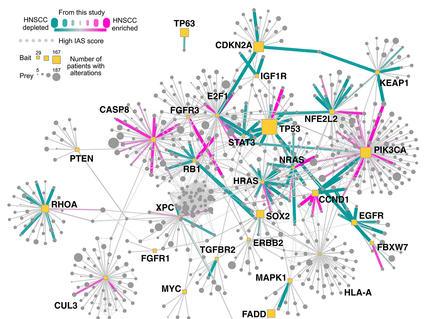Dr. Trey Ideker: Mapping the Circuitry of a Cancer Cell
Trey Ideker, Ph.D., a CSBC Investigator at the University of California, San Diego (UCSD), is working to map the circuits of a cancer cell. After training in electrical engineering, he found himself, like many other engineering and computer science graduates, working in the defense sector.
However, according to Dr. Ideker, “the fact that I was facilitating mass destruction didn’t sit well on my conscience, so I knew that I needed to find a different career.” He thought that biotechnology might be the next big thing in the computer industry and decided to make a switch and study molecular biology.
In this interview he discusses mentorship, systems biology, and his CSBC research with Dr. Nevan Krogan.
Is there a particular mentor who helped you during your career journey?
Lee Hood is the reason that I applied to graduate school in molecular biology. I read about his work in a book that was a popular New York Times bestseller on biotechnology at that time (i.e., The Code of Codes: Scientific and Social Issues in the Human Genome Project). It had a chapter about Hood and the genome sequencing he was doing.
I contacted Lee and asked for his advice about studying biology, and he encouraged me to apply to a Ph.D. program.
What impact did a paper you published as a graduate student have on systems biology?
This paper reported one of the first efforts to map and model a gene network, which helped kick off the field of systems biology. It showed how systematic genomic measurements could be used to develop a model of a cell. In a way, the entire goal of systems biology is to automate the process of mapping and modeling biological systems.
How do you think machine learning can contribute to cancer cell biology?
Lately there’s been a lot of interest in applying artificial intelligence (AI) and deep learning to cancer. Yet, interpreting cancer patient data is going to be even harder than using an AI computer program, like AlphaGo, to win a board game.
To move forward, one strategy we have been investigating is to couple deep learning with knowledge about cell biology. AI is currently a black box that learns to associate outputs with input patterns using intertwined tangles of simulated neurons, also known as artificial neural networks. However, we can constrain the simulated neurons to specifically model a certain biological system rather than grow an arbitrary tangle of neurons.
My laboratory just reported a deep learning model of a budding yeast cell in Nature Methods. We developed a deep neural network that can take the input of any pattern of mutations made to a yeast cell and translate that into the output of yeast growth. Having finished this ‘warm-up’, we hope to now develop a similar model that predicts the growth phenotype for a cancer cell using deep learning.
What is the Cancer Cell Map Initiative (CCMI)?
The CCMI is a project that was inspired by The Human Genome Project, which sequenced and mapped all of the genes found in people. However, to understand and treat cancer, we need to move beyond gene sequences to map the rest of the structure and function of a cancer cell.
Cancer is not caused by a single mutation, but comes from patterns of many mutations and gene interactions impacting the cellular circuit over time. To understand what goes wrong in a cancer cell network, we need to create a wiring map of a cancer cell.
Can you describe the Network Data Exchange (NDEx) 2.0?
NDEx is an example of how NCI Program Directors work closely with investigators. NCI staff in DCB helped us start the database through the NCI Informatics Technology for Cancer Research (ITCR) program that is complementary to the CSBC.
NDEx 2.0 is a cloud for cancer gene networks to get consensus about cancer cell wiring diagrams. It also leverages software that we developed, known as Cytoscape, which is a popular computational tool in systems biology for visualizing the networks of cells.
The database is a repository for the wiring maps of a cancer cell. I think of it as a Facebook for networks. Just as you can adjust the privacy settings for information shared on a social media platform, you can choose how you share a network diagram within the NDEx.
For example, while you are still developing a network, you can share it with a group of lab colleagues. Then, once the data is published in a journal, you can move this private network into the public domain.

